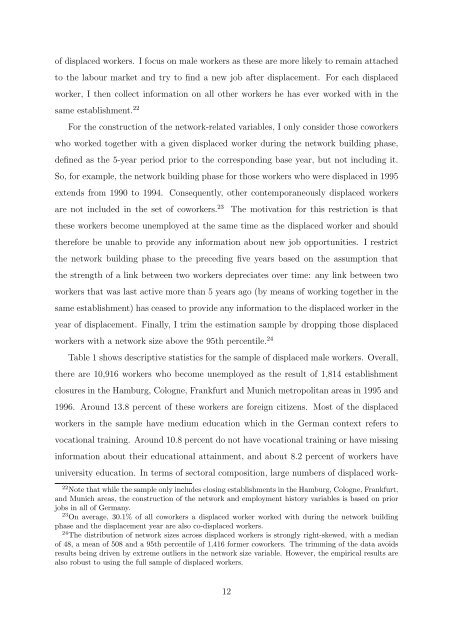paper - Universitat Pompeu Fabra
paper - Universitat Pompeu Fabra
paper - Universitat Pompeu Fabra
Create successful ePaper yourself
Turn your PDF publications into a flip-book with our unique Google optimized e-Paper software.
of displaced workers. I focus on male workers as these are more likely to remain attached<br />
to the labour market and try to find a new job after displacement. For each displaced<br />
worker, I then collect information on all other workers he has ever worked with in the<br />
same establishment. 22<br />
For the construction of the network-related variables, I only consider those coworkers<br />
who worked together with a given displaced worker during the network building phase,<br />
defined as the 5-year period prior to the corresponding base year, but not including it.<br />
So, for example, the network building phase for those workers who were displaced in 1995<br />
extends from 1990 to 1994. Consequently, other contemporaneously displaced workers<br />
are not included in the set of coworkers. 23<br />
The motivation for this restriction is that<br />
these workers become unemployed at the same time as the displaced worker and should<br />
therefore be unable to provide any information about new job opportunities. I restrict<br />
the network building phase to the preceding five years based on the assumption that<br />
the strength of a link between two workers depreciates over time: any link between two<br />
workers that was last active more than 5 years ago (by means of working together in the<br />
same establishment) has ceased to provide any information to the displaced worker in the<br />
year of displacement. Finally, I trim the estimation sample by dropping those displaced<br />
workers with a network size above the 95th percentile. 24<br />
Table 1 shows descriptive statistics for the sample of displaced male workers. Overall,<br />
there are 10,916 workers who become unemployed as the result of 1,814 establishment<br />
closures in the Hamburg, Cologne, Frankfurt and Munich metropolitan areas in 1995 and<br />
1996. Around 13.8 percent of these workers are foreign citizens. Most of the displaced<br />
workers in the sample have medium education which in the German context refers to<br />
vocational training. Around 10.8 percent do not have vocational training or have missing<br />
information about their educational attainment, and about 8.2 percent of workers have<br />
university education. In terms of sectoral composition, large numbers of displaced work-<br />
22 Note that while the sample only includes closing establishments in the Hamburg, Cologne, Frankfurt,<br />
and Munich areas, the construction of the network and employment history variables is based on prior<br />
jobs in all of Germany.<br />
23 On average, 30.1% of all coworkers a displaced worker worked with during the network building<br />
phase and the displacement year are also co-displaced workers.<br />
24 The distribution of network sizes across displaced workers is strongly right-skewed, with a median<br />
of 48, a mean of 508 and a 95th percentile of 1,416 former coworkers. The trimming of the data avoids<br />
results being driven by extreme outliers in the network size variable. However, the empirical results are<br />
also robust to using the full sample of displaced workers.<br />
12
















